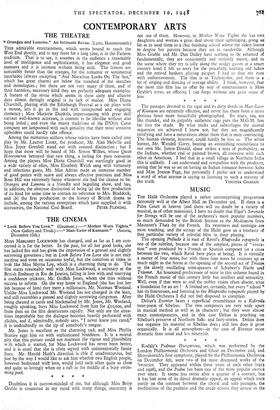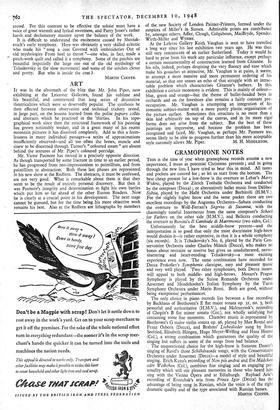MUSIC
THE Halle Orchestra played a rather unenterprising programme extremely well at the Albert Hall on December 3rd. If there is a Palm Court in heaven (and there will no doubt be a variety of musical, as of other mansions), I have no doubt that Elgar's Serenade for Strings will be one of the orchestra's most popular numbers, as much demanded by the British Section as the Meditation from Massenet's Thais by the French. Its sweetness and nostalgia are most touching, and the strings of the Halle gave us a foretaste of that particular variety of celestial bliss in their playing. The opening Prelude a la nuit of Ravel's Rhapsodie espagnole is one of the subtlest, because one of the simplest, pieces of " evoca- tion " ever produced by a French or Spanish composer (or a cross between the two, which Ravel here plays at being). It is virtually a matter of four notes, but with those four notes he conjures up as much night as the horns at the opening of the second act of Tristan or the slowly oscillating semi-quavers of Schubert's Nacht and Triiume. An honoured predecessor of mine in this column found in the French music of this century little but intellect and sensuality. Well, even if that were so and the nobler vision often absent, what a foundation for an art ! A limited art, certainly, but every "school " has its limitations, and listening to the Rhapsodie espagnole played by the Halle Orchestra I did not feel disposed to complain. Delius's Eventyr bears a superficial resemblance to a Kalevala tone-poem of Sibelius. The two composers are very wide apart in musical method as well as in character ; but they were almost exact contemporaries, and in this case Delius is poaching on Sibelius's preserve of Northern folk- and fairy-stories. Delius does not organise his material as Sibelius does ; still less does it grow organically. It is all atmosphere—in the case of Eventyr more dramatic than usual and less ninetyish.
* * * *
Kodaly's Psalmus Hungaricus, which was performed by the London Philharmonic Orchestra and Choir on December and, and Shostakovich's first symphony, played by the Philharmonia Orchestra on December 6th, were two of the most discussed works of the 'twenties. They appeared within three years of each other (1923 and 1926), and the Psalm has been one of the most popular exotics ever since. It seems less exotic after a quarter of a century, but it has lost none of its direct dramatic appeal, an appeal which rests partly on the contrast between the choral and solo passages, the meditations of the psalmist and the crude echoes they arouse in the
crowd. For this contrast to be effective the soloist must have a voice of great warmth and lyrical sweetness, and Parry Jones's rather harsh and declamatory manner upset the balance of the work.
It is difficult to understand the excitement caused by Shostak- ovich's early symphony. Here was obviously a very skilled eclectic who made his " song a coat Covered with embroideries Out of old mythologies From heel to throat "—one who, in fact, made a patch-work quilt and called it a symphony. Some of the patches are beautiful (especially the large one out of the old mythology of Tchaikovsky in the slow movement) and some of the stitches clever and pretty. But who is inside the coat ?
MARTIN COOPER.















































 Previous page
Previous page